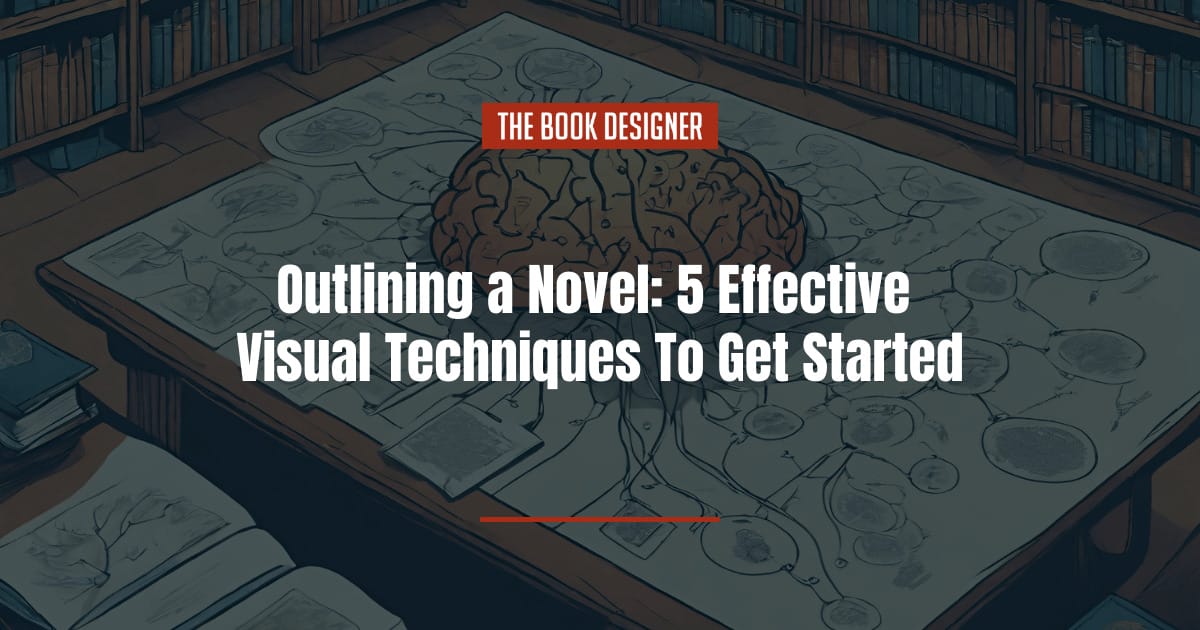As a writer, it’s common for you to imagine your stories, to see in your mind’s eye how each scene plays out — the appearance of your protagonists and antagonists, the setting in which the story takes place, and the motivations of each character.
But sometimes, imagination isn’t enough to help you plan a story’s structure. That’s where visual techniques come into play. Using visual techniques to outline a novel makes it easier for you to understand the story’s elements and progression. It also helps you identify gaps in the plot, find more material, and create a structure that guides your draft.
In this article, you’ll learn about five visual techniques you can use to get started with your novel outline.
Here’s what you need to know about outlining a novel using visual techniques:
5 Visual Techniques You Can Use to Outline a Novel
1. Mind Maps
A mind map is a visual diagram that represents concepts, ideas, or information usually organized around a central theme or topic. It consists of a main idea in the center of a page, with branches spreading out to represent the units or modules of that idea. A mind map of a novel looks something like this:

To outline a novel with a mind map, start by writing down the main theme of your novel in the center of the map. Then, make branches leading from your central theme to represent the key elements of your novel, including the characters, plot points, settings, and themes. You can add further branches to represent subplots, character arcs, and other related details.
A mind map can help you see how different parts of your story connect together. It also allows you to see plot gaps and plot points that don’t fit into the overall story. This way, you can tweak the diagram by removing unnecessary plot points, adding more material to make the story more cohesive, or changing certain aspects altogether.
If your story, however, involves a lot of worldbuilding — this is common with fantasy novels — you could create physical maps to help you keep track of time, locations, movement, and travel within the story.
For example, physical maps played an integral part in J.R.R. Tolkien’s worldbuilding process in The Lord of the Rings. He drew detailed maps, plotted charts, and made chronological documents to help him make the complex fictional world of Middle-earth believable.
2. Storyboards
A storyboard is a series of illustrated frames or panels depicting a story’s sequence of events. While storyboards are commonly used in animation, graphic novels, and filmmaking, novelists can adapt this technique to outline their novels and visualize the flow of the narrative.

A storyboard can help you:
- Describe and sketch scenes from your novel. This allows you to visualize the progression of the story.
- Understand the flow of events, and identify gaps or inconsistencies in the narrative.
- Keep track of where your characters are in each scene. This ensures that their actions and interactions are consistent throughout the story.
- Control the pacing of your novel. For example, it’ll help you properly intersperse moments of excitement or tension with quieter moments.
- Identify key plot points, climactic moments, and twists, ensuring they are well-distributed throughout the story.
- See how your subplots intersect with the main plot. This ensures that your story is well-woven and satisfying.
To outline a novel using a storyboard, take the following:
- Break your novel down into its most important chapters, moments, or scenes.
- Write a one or two-sentence description of what will happen in each scene.
- Make sketches of these key scenes. While you don’t have to be a world-class artist to do this, your sketches should represent the description of these scenes.
- In the storyboard, write a one-sentence description that connects the key scenes and drives the narrative forward.
- Take a step back and review your storyboard. Here, you can add or remove new scenes, and change the placement of certain scenes to make the story flow better. You can also include any hints, twists, or discoveries you want your readers to make.
3. Flowcharts
A flowchart is a diagram that uses symbols and connectors (like arrows) to represent the flow of actions, information, or processes. It’s a great way to break down complex storylines into a structured, visual format. This way, you can see the relationships between events, subplots, and character decisions — all of which make for a well-organized and engaging story.

Here’s how you can use flowcharts to outline your novel:
- Begin by identifying the major events or plot points in your novel. Make each event a box or node in the flowchart.
- Use arrows to connect the events in the order they occur. This visually represents the flow of the narrative.
- If your story involves characters facing dilemmas or making hard choices, you can use diamond-shaped nodes to represent decision points. Label these nodes with the available choices.
- Create additional branches in the flowchart to represent subplots. Connect these subplots to the main events or decision points intersecting with the main plot.
- Use separate boxes or nodes to outline character arcs. This helps you track how each character’s journey evolves throughout the story.
- If the story goes back and forth in time (or setting), make nodes to represent these changes.
- For complex plots, you may need to add loops in the flowchart that represent events or decisions that influence each other.
- After creating your initial flowchart, review it to ensure that all key elements are included and the narrative flows logically. Make adjustments as needed.
4. Index Cards or Post-It Notes
Index cards or Post-it notes are small, portable pieces of paper that can be easily arranged and rearranged. Authors can write key plot points, character details, or scene summaries on separate cards or notes, and then physically (re)arrange them on a flat surface, allowing for easy restructuring of the plot.
An author who famously used index cards to outline their novel(s) is Vladimir Nabokov. He used index cards to plan and organize his famous 1955 novel, Lolita. Nabokov would jot down individual scenes, details, and ideas on index cards in no particular order. He free-wheeled these ideas, knowing that the cards gave him the flexibility to restructure the narrative however he wished.
Here’s one of Nabokov’s notes:

“I do not begin my novel at the beginning,” Nabokov says in his 1967 interview with Herbert Gold for The Paris Review. “I do not reach chapter three before I reach chapter four; I do not go dutifully from one page to the next, in consecutive order. No, I pick out a bit here and a bit there, till I have filled all the gaps on paper.”
On his particular outlining method, Nabokov explains, “The pattern of the thing precedes the thing. I fill in the gaps of the crosswords at any point I happen to choose. These bits I write on index cards until the novel is done. My schedule is flexible, but I am rather particular about my instruments: lined Bristol cards and well-sharpened, not too hard, pencils capped with erasers.”

Just like Nabokov, here’s how you can use index cards and Post-it notes to outline your novel:
- Write down individual scenes or key plot points on separate cards/notes.
- Use a large table, wall, or bulletin board to pin or lay out the cards/notes. This makes it easier to see the flow of the narrative.
- Arrange the cards/notes in the order they occur in the story. This helps you see the progression of events, and identify any narrative inconsistencies.
- Use different colored cards/notes to represent different characters. This allows you to track their movement in each scene and ensure their arcs are well-developed.
- Assign specific colors or labels to cards/notes related to subplots, character arcs, or themes. This helps you see how these elements intersect with the main plot.
- Draw icons or symbols on the cards/notes to represent specific elements. For example, a question mark for a mysterious element and a heart symbol for a romantic subplot.
- As you write and revise, move or replace the cards/notes to reflect changes in the plot or character development.
- At the end, step back and view the entire layout. This allows you to identify areas that may need further development or refinement.
5. Visual Collages
A visual collage (or mood board) is a collection of images, photos, and visual elements that evoke the mood, setting, or themes of the story. Authors can use visual collages to stimulate creativity and provide a visual reference for their novels during the writing process.

Here’s how you can use visual collages to outline your novel:
- Collect images, photographs, illustrations, and other visual elements that represent aspects of your novel (e.g. pictures of real or imaginary locations, objects, symbols, or scenes).
For example, if you’re writing a historical mystery, you might collect images of old castles, dark alleyways, and eerie artwork. This helps you describe the settings in your novels, making your writing more vivid or immersive. The visuals can also serve as cues for recurring elements.
- Include pictures that represent your characters. This can help you visualize them and understand their physical appearance, personality, and motivations more deeply.
- Use a physical board, a notebook, or a digital platform to arrange these visuals. You can physically cut and paste the images on a surface or arrange them digitally.
- Group visuals based on common themes, characters, settings, or plot elements. This helps you see the connections and relationships between different aspects of your story.
- Write captions or notes beside the images to remind yourself of specific details, ideas, or inspiration associated with each visual.
- Keep your visual collage within reach while you’re writing to help you maintain consistency in your descriptions and world-building.
Elevate Your Novel with Visual Outlining
Using visual techniques such as mind maps, storyboards, and index cards for outlining a novel can help you breathe life into your narrative and navigate the intricate web of plot threads with clarity and precision. Not only does this enhance your creativity, but it also fosters a deeper connection between you and the story you want to tell.
So whether you’re a budding wordsmith or a seasoned novelist, consider incorporating visual techniques into your outlining process. You’ll find that they are a dynamic and interactive way to give an amorphous idea some shape and refinement.




